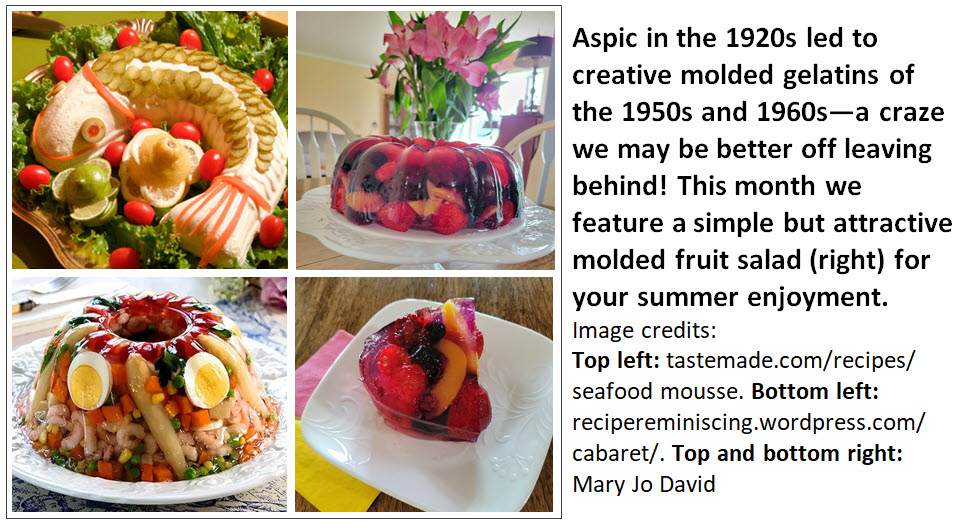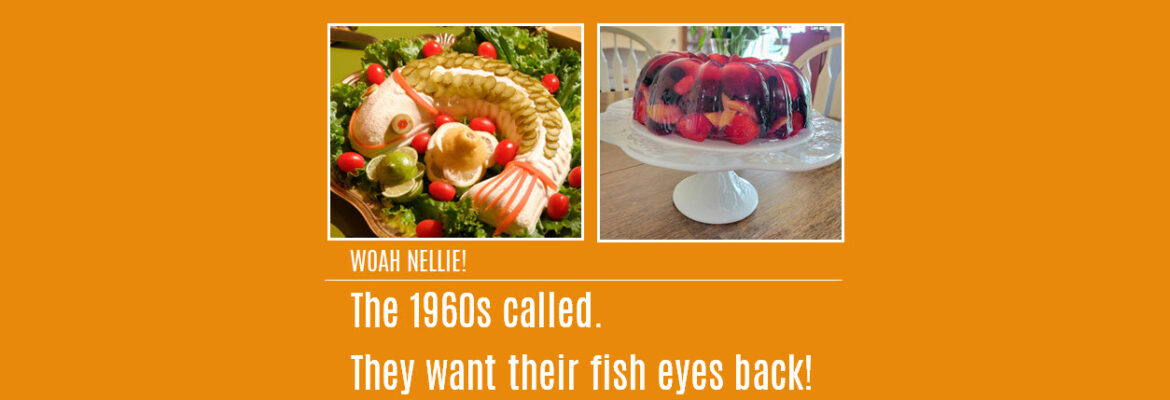Woah Nellie!
The 1960s called. They want their fish eyes back!
by Mary Jo David
What is it about olives—whether green or black—that led someone to say, “I think these would make wonderful fish eyes in a molded salad?” J That idea caught on in the 1960s, and many samples are viewable on the Internet today, like seafood mousse, tuna gelatin mold, and Thousand Island salmon spread.
What does this have to do with Nellie Maxwell’s columns from 100 years ago? After scrolling through the 100-year-old August issues of the Stockbridge Brief-Sun, nothing was really grabbing me. Admittedly, this column has been light on main dishes, so I was really hoping for a good dinner recipe this month. But alas, it was not to be. I scrolled past “Calves Liver en Casserole,” “Codfish Gravy,” “Stuffed Calves Hearts,” and “Larded Liver” before I gave up on main dishes. (Thank me later!)
That brought me to a couple Nellie recipes for “Aspic Jelly,” which is basically solidified chicken or beef consommé that gelatinized in the icebox after boiling the bones. Fun fact: Frigidaire and later General Electric began manufacturing refrigerators in the 1920s, but most U.S. households were keeping aspic and other foods cold using simple iceboxes in 1924.
Another advancement that promoted 1900’s aspics and molded salads was the Knox company discovering how to granulate gelatin in the late 1800s. Some of Nellie’s recipes call for adding this clear gelatin. Fancy, copper gelatin molds began appearing in the 1920s but usually in the homes of the well-to-do. They became much more common in average households in the 1950s and 1960s, often gracing the walls of midcentury modern kitchens.
Going back to Nellie’s August 1924 columns, other than providing a source of collagen, her “Aspic Jelly” recipes just didn’t seem exciting enough to devote a column to. But by then, my love affair with gelatin salads had resurfaced, and I decided, as the originator of this column, I could branch out a bit.
In all these years, I have never used Knox clear gelatin in a recipe. And I wasn’t about to start with a recipe that called for fish eyes. Instead, I began googling and found a perfect summertime recipe that would not cause me to lose readers!
This month’s recipe is “Molded Fruit Side Salad,” which, although it was somewhat inspired by Nellie’s “Aspic Jelly” recipe, is much more attractive and edible. I found a Facebook group called Struggle Meals, and watched Frankie Celenza come up with a “Fun Twist on a Side Salad,” so I decided to follow his lead.
His recipe wasn’t printed anywhere, and I did make some modifications, so here is the modified recipe:
Molded Fruit Side Salad
4 envelopes Knox unflavored gelatin
3 cups Water
1-1/4 cups Sugar
1 Lemon (juice only)
6 ounces Fresh raspberries
1 can (29 ounces) Peaches, drained
16 ounces Frozen cherry berry fruit medley, thawed
16 ounces Fresh strawberries, hulled
Boil two cups of water with the sugar added. Stir until the sugar dissolves.
Take note: The most basic instructions for using unflavored gelatin are not on the Knox packaging. After googling, I discovered that, for our recipe, you need to stir the contents of all the gelatin packets into one cup of room temperature water to “bloom.” (Do this in a large mixing bowl; I used my late mother-in-law’s bowl for good luck!) After a few minutes, add the two cups of boiled sugar water to the gelatin and stir for about three to five minutes until the combination thickens. Add the lemon juice and stir.
Meanwhile, in a Bundt-style pan, place the raspberries in a nice pattern on the bottom. Gently add in the thawed fruit medley. Top the fruit with peaches arranged in a nice pattern. Top the peaches with the strawberries, bottom-side down, covering as much of the fruit surface as possible.
Use a cup to gently pour the gelatin over the fruit arrangement. Fill to near the top of the pan. The peaks of the strawberries may be left uncovered; that’s fine. Carefully place the pan into the refrigerator and chill overnight. (Wait to cover the pan until the gelatin sets a bit.) When ready to serve, set the pan into warm water for less than a minute to loosen the gelatin from the sides of the pan. Turn the fruit salad out onto a plate and serve.
All that was left was finding out what the resident taste-tester thought about the recipe. Between forkfuls, he managed to comment, “Friendly would be proud!” (Friendly—yes, that was her real name—was born around the turn of the 20th century and was famous for showing up to family parties with multi-layer gelatin salads tall enough to rival a wedding cake!)
I agree with my taste-tester; I think I can safely recommend this “Molded Fruit Side Salad” to readers. As gelatinized salads go, this one is really quite attractive and, because it doesn’t call for olive eyes, it shouldn’t scare any of your guests away!



